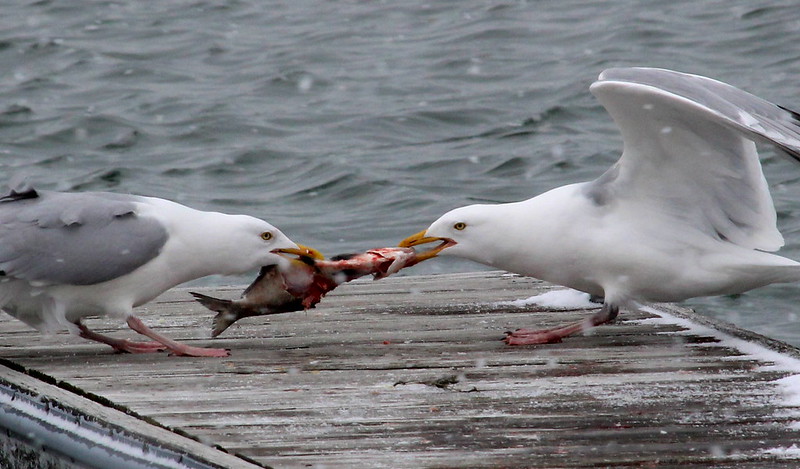By Chelsea Jandreau
If someone were to ask what animals you find near your home or in your neighborhood, what comes to mind? I live near a lake and with that comes a rotating batch of waterfowl and other birds. The geese and ducks fluctuate in number as the seasons change. The occasional osprey or hawk makes an appearance. Some birds, like the Tundra Swans and Buffleheads, come through for a while and then disappear to their preferred climates for the rest of the year.
However, the bird that never fails to be front and center, present in even the windiest, worst weather is the rarely loved seagull. I’ll admit it; historically I was also not a huge fan of these birds. Honestly, I think I’ve held some small vendetta against them ever since I was a child who had their mint chocolate chip ice cream grabbed out of their hand by a dive bombing seagull before I could even take a bite. However, I have to give them some sort of recognition for their incredible ability to live anywhere and everywhere, even if that survival instinct leads them to take ice cream from unsuspecting children.
Now, there is not just one bird technically called a seagull, and instead there are many different kinds of gulls that live across North America. In the wild, gulls will eat fish, crustaceans, insects, seeds, and a truly impressive continuing list of plants and animals. They are excellent scavengers, and they are the very picture of a generalist. They will eat dead animals washed up on the beach as well as those french fries that were dumped in the parking lot. Gulls have never been particularly picky and they seem to have forgotten what fear feels like when it comes to the humans and cars they are often surrounded by.

Most gulls are pictured living near lakes and oceans. Although that may have been the habitat where they originated, they have spread across shopping malls, parks and cornfields everywhere. They swim, fly, walk and hop their way around, usually in large groups, looking for food.
Gulls are a great example of an animal that is thriving in an urban setting, but they definitely are not the only animal one might find living near people. Think about that list of animals you might find in your neighborhood or down the street. If you really take the time to observe what is going on outside, that list is probably a long one. Animals need food, shelter, water and as long as they can find enough of those things, they are able to survive outside of their normal wild habitat, even in densely populated cities.
Racoons and opossums are omnivores that eat a wide range of food, including the food left in our trash. Deer and squirrels eat many kinds of plants, leaves, flowers and nuts found both in the woods and in our yards and gardens. Foxes, bobcats and other small carnivores then feed on the mice, squirrels and other small animals that successfully live in urban areas. In multiple cities across America, there are even thriving populations of coyotes.
The animals found in yards, parks and grocery store parking lots are generalists. They have certain categories of food they eat, but they are able to eat a wide variety of things within those guidelines. On the other end of the spectrum are the animals that do not do so well in urban areas. These animals struggle with disappearing and quickly changing habitats. From a food standpoint, often these struggling animals are specialists and require very specific types of food. One of those well-known specialist species is the Monarch butterfly. As caterpillars, they only eat from the family of milkweed plants. All caterpillars are wired to eat the food that gives them the nutrients they need, but many other types of caterpillars have a wider range that fits within their diet. Since Monarch caterpillars have such a specific diet, changes in habitat mean a change in food availability, usually not for the better.

As humans have continued to spread out and settle in places that were once home to other animals, the animals have been forced to adapt. Some, like the gulls, are thriving in their new human-filled habitats, while others have not been so lucky. We are capable of sharing our own habitat, and as the landscape continues to change with humans, that means we will need to be conscious of increasing animal interactions, whether those animals are getting inside of houses or dealing with animals on the roads. These animals are not going away, so it makes sense to instead figure out ways to live with them rather than constantly battle their presence.
Chelsea Jandreau is a Nature Educator at Audubon Community Nature Center.
Audubon Community Nature Center builds and nurtures connections between people and nature. ACNC is located just east of Route 62 between Warren and Jamestown. The trails are open from dawn to dusk and birds of prey can be viewed anytime the trails are open. The Nature Center is open from 10 a.m. until 4:30 p.m. daily except Sunday when it opens at 1 p.m. More information can be found online at auduboncnc.org or by calling (716) 569-2345.


Recent Comments